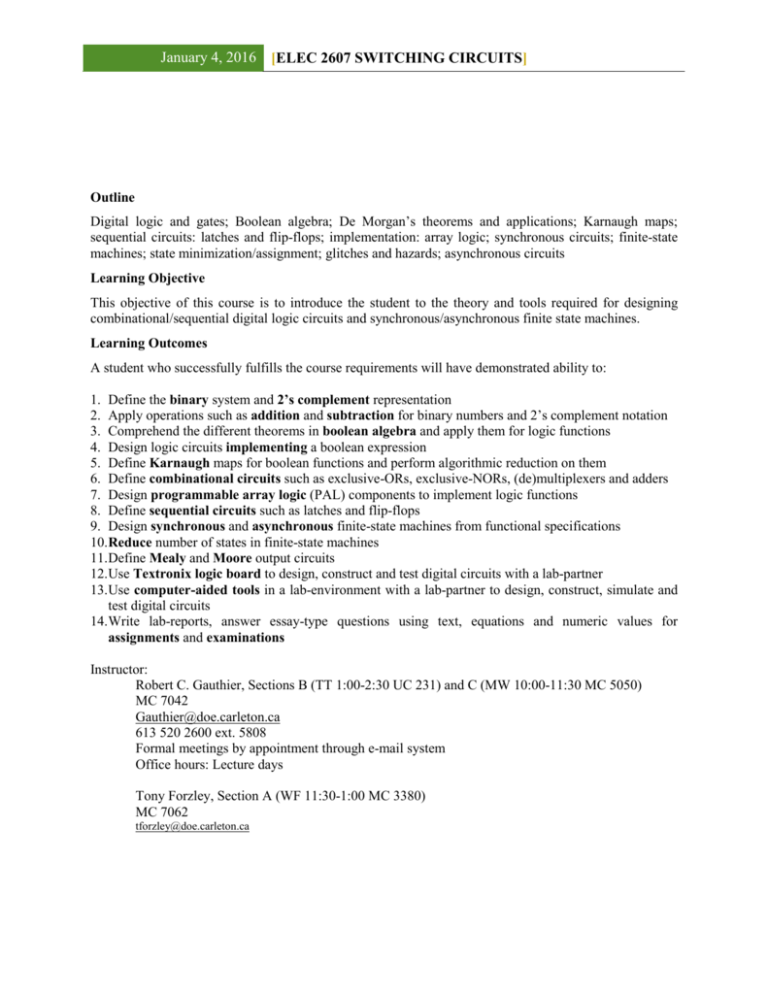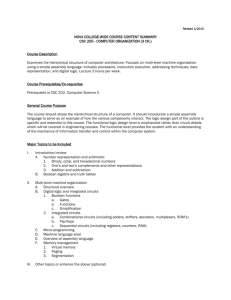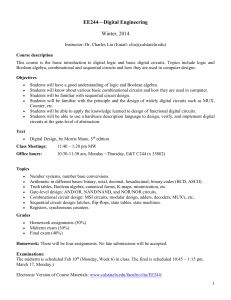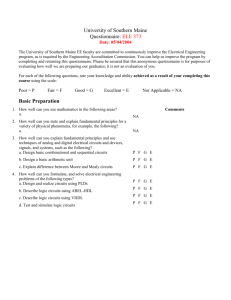Course Outline ELEC 2607 [Winter 2015 2016 Revised January 4
advertisement

January 4, 2016 [ELEC 2607 SWITCHING CIRCUITS] Outline Digital logic and gates; Boolean algebra; De Morgan’s theorems and applications; Karnaugh maps; sequential circuits: latches and flip-flops; implementation: array logic; synchronous circuits; finite-state machines; state minimization/assignment; glitches and hazards; asynchronous circuits Learning Objective This objective of this course is to introduce the student to the theory and tools required for designing combinational/sequential digital logic circuits and synchronous/asynchronous finite state machines. Learning Outcomes A student who successfully fulfills the course requirements will have demonstrated ability to: 1. Define the binary system and 2’s complement representation 2. Apply operations such as addition and subtraction for binary numbers and 2’s complement notation 3. Comprehend the different theorems in boolean algebra and apply them for logic functions 4. Design logic circuits implementing a boolean expression 5. Define Karnaugh maps for boolean functions and perform algorithmic reduction on them 6. Define combinational circuits such as exclusive-ORs, exclusive-NORs, (de)multiplexers and adders 7. Design programmable array logic (PAL) components to implement logic functions 8. Define sequential circuits such as latches and flip-flops 9. Design synchronous and asynchronous finite-state machines from functional specifications 10. Reduce number of states in finite-state machines 11. Define Mealy and Moore output circuits 12. Use Textronix logic board to design, construct and test digital circuits with a lab-partner 13. Use computer-aided tools in a lab-environment with a lab-partner to design, construct, simulate and test digital circuits 14. Write lab-reports, answer essay-type questions using text, equations and numeric values for assignments and examinations Instructor: Robert C. Gauthier, Sections B (TT 1:00-2:30 UC 231) and C (MW 10:00-11:30 MC 5050) MC 7042 Gauthier@doe.carleton.ca 613 520 2600 ext. 5808 Formal meetings by appointment through e-mail system Office hours: Lecture days Tony Forzley, Section A (WF 11:30-1:00 MC 3380) MC 7062 tforzley@doe.carleton.ca January 4, 2016 [ELEC 2607 SWITCHING CIRCUITS] Evaluation Scheme Labs Assignments Midterm Final 20% 10% 20% 50% Lab exemptions cannot be given for accreditation purposes. Students need to obtain a minimum of 50% in their term mark (labs + assignments + midterms) and the final examination in order to pass the course. Students should also do all the labs and get 50% or higher in their overall lab mark to pass this course. Required Textbooks: It is highly recommended that you purchase (and read from time to time) the two textbooks indicated. The first is a general reference text outlining the fundamentals of digital switching circuits. The second is a more advanced text treating applications. 1) “Digital Fundamentals”, Eleventh Edition, Floyd, Pearson, ISBN 0-13-273796-8. 2) “Logic and Computer Design Fundamentals”, fifth edition, M.M. Mano, C. R. Kime and T. Martin, Pearson, Hoboken New Jersey, ISBN 0-13376063. Other References I Consult from Time to Time A) “Digital Design Principles and Practices”, fourth edition, J. W. Wakerly, Pearson, ISBN 0-13-186389-4. B) “Digital Design”, M. M. Mano, Prentice Hall, ISBN 0-13-212333-9. C) “Digital Systems Principles and Applications, fifth edition, R. J. Tocci, Prentice Hall, ISBN 0-13-213224-9. D) “Digital Design from Zero to One”, J. D. Daniels, Wiley, ISBN 0-471-12447-8. E) F) “Boolean Algebra and Switching Circuits”, E. Mendelson, Schaum’s Outline Series, McGraw-Hill Book Company, ISBN 07-041460-2. Lecture notes available from CuLearn (also on course web page) Miscellaneous Notes 1. Students with disabilities requiring academic accommodations in this course are encouraged to contact a coordinator at the Paul Menton Centre for Students with Disabilities to complete the necessary letters of accommodation. After registering with the PMC, make an appointment to meet and discuss your needs with the course coordinator at least two weeks prior to the first in-class test or midterm exam. This is necessary in order to ensure sufficient time to make the necessary arrangements. 2. Requests for religious accommodations should be sent to the course coordinator by 31st Jan 2015. Religious obligations that coincide with the mid-term will be dealt with by moving the weight of the mid-term to the final. January 4, 2016 [ELEC 2607 SWITCHING CIRCUITS] COURSE SCHEDULE Week 0: January 4 – Welcome – Course outline No Lab Week 1: January 11 – Boolean Algebra Lab 0 / Introduction Week 2: January 18 – DeMorgans Laws Lab 0 / Introduction Week 3: January 25 – Binary Numbers / Karnaugh Maps Lab [1] – Telephone Exchange Week 4: February 1 – Latches and Flip Flops Lab [1] – Telephone Exchange Week 5: February 8 – Finite State Machines Lab [2] – Binary Adder/Subtracter -------------------------------------------------------------- Break ---------------------------------------------------------------------Week 6: February 22 – State Reduction Lab [2] – Binary Adder/Subtracter Week 7: February 29 – Glitches and Hazards Lab [3] – T-Bird Tail Lights Week 8: March 7 – Asynchronous FSMs Lab [3] – T-Bird Tail Lights Week 9: March 14 – Implementation Lab [4] – Midi Interface (Part 1) Week 10: March 21 – Factoring and Multiplying Out Lab [4] – Midi Interface (Part 1) Week 11: March 28 – Multiple Output Maps Lab [5] – Midi Interface (Part 2) Week 12: April 4 – Product State Graphs Lab [5] – Midi Interface (Part 2) Week 12: April 6 -- End of classes lecture Switching Circuits - ELEC 2607 - Winter 2015 3





